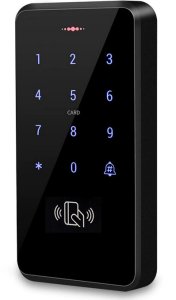Wiegand keypad and tag reader
The wiegand component allows you to integrate Wiegand-standard key
input and card or tag reader panels in Home Assistant.

ℹ️ Note
Some keypads are preconfigured by the factory to act as Wiegand input devices. In order to work with this component, they may need to be reconfigured to act as Wiegand 26 output or Wiegand 34 output devices.
# Example configuration entry
wiegand:
- id: mykeypad
d0: GPIOXX
d1: GPIOXX
on_key:
- lambda: ESP_LOGI("KEY", "received key %d", x);
on_tag:
- lambda: ESP_LOGI("TAG", "received tag %s", x.c_str());
on_raw:
- lambda: ESP_LOGI("RAW", "received raw %d bits, value %llx", bits, value);Configuration variables
id (Optional, ID): Set the ID of this device for use in lambdas.
d0 (Required, Pin Schema): The pin where the
D0output of the Wiegand’s interface connects.d1 (Required, Pin Schema): The pin where the
D1output of the Wiegand’s interface connects.
Triggers
on_key (Optional, Automation): An automation to perform when a key has been pressed on the pad. The key is in a variable called
x.on_tag (Optional, Automation): An automation to perform when a Wiegand-compatible card or a tag has been read by the device. The tag code is in a variable called
x.on_raw (Optional, Automation): An automation to perform for any data sent by the device. The value is in a variable called
value, the number of bits is in a variable calledbits. Note that this will include parity bits as well and no parity checking is done.
ℹ️ Note
Automatic handling of multiple keys (e.g. PIN code entry) is possible with the the Key Collector component.
Keys 10 and 11 are
*and#. They might be labelled asENTorESC, but check the logs to see which key code you get and use the corresponding character.

